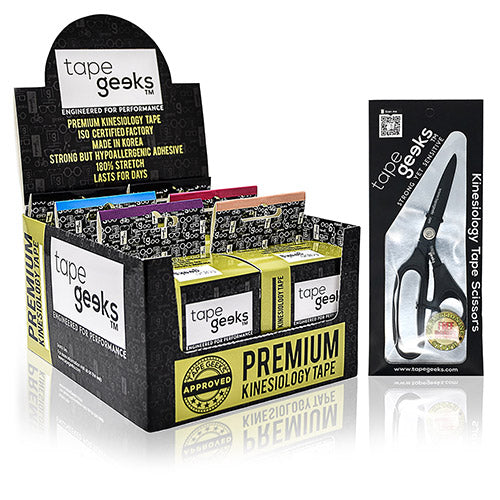
There are many different ways that you can cut kinesiology tape. You may be wondering why there is a need for so many cuts when they all seem to do the same thing. But trust us, they’re not all the same.
Each cut is designed for different areas of the body with specific purposes in mind.

Shop our bundles now
Shop NowSome of the many benefits can be helping with pain relief, improving range of motion, increasing blood flow to an area, or even helping with common injuries like shin splints. Some even use kinesiology tape to increase joint space to help alleviate discomfort and even pain.
In this blog post, we will explore some of the most popular types of kinesiology tape cuts. We'll also discuss how you can make them and what they are best used for!
I-strip
Perhaps the most recognizable and simplest cut that you can make for kinesiology tape, the I-strip is simply a length of tape that you cut to help with a variety of injuries as well as create support for muscles, tendons, and ligaments. This tape cut is commonly used for taping protocols for the rotator cuff, Achilles tendon, quadriceps, and gluteus muscles.
How to cut an I-strip:
- Measure your tape to your desired length.
- Round your edges to prevent premature peeling.
Y-strip
The Y-strip is often used for taping applications to target more sensitive areas like the front of the elbow and behind the knee. It’s also used for taping protocols to control the position of the kneecap.
How to cut a Y-strip
- Measure your tape to your desired length and make an I-strip.
- Note how long you want the base and the tail should be. Then, cut the tape vertically, creating two tails.
- Round the edges of your base and tails.
Fan-cut
A fan cut is commonly used for lymphatic drainage to help with swelling and edema. It aims to reduce pressure from an area that will allow the lymphatic fluid to drain away through the nearby lymph nodes.
How to cut a Fan-strip
- Measure your tape to your desired length and make an I-strip.
- To make for easier and equal cutting, Tape Geeks kinesiology tapes have grid lines at the back. Determine how many fan cuts you’ll need and make vertical cuts following the lines at the back.
- Round the edges of the base as well as each edge of the fan.
Web-cut
Also used for edema, the web-cut has its ends intact, unlike the fan cut. This type of cut also relieves pressure from the edema or a swollen affected area by aiding lymphatic drainage and give effective relief.
How to cut a Web-strip
- Measure your tape to your desired length and make an I-strip.
- Determine how many cuts you’ll need and how long your base should be. To make the cutting easier, fold your tape in half.
- For more equal cutting, you can follow the lines placed at the backing of the tape.
- Round your edges.
X-strip with a donut hole
An X-strip is commonly used for sensitive areas of the body like the back of the knees, elbows. It’s also commonly used for the hamstrings. This cut is used to cross several joints and can cover large areas of the body. The donut cut, on the other hand, is used to inhibit used or overstretched muscles.
How to cut an x-strip with a donut hole
- Measure a piece of kinesiology tape to your desired length and make an I-strip.
- Fold the tape in half and make a cut between the two ends to make four tails - two tails on both sides.
- Round the edges of your tails.
- Then, if you want the donut hole, fold the tape in half and cut the hole depending on the size of the body part that you’ll be using it on.
Buy Tape Geeks Taping Scissors for Smooth, Gum-Free Cutting
Kinesiology taping can be challenging if you don’t have the right tools for the job. This is why Tape Geeks has done its research to design products that’ll make taping as easy and as hassle-free as possible even for those who are just starting out on their kin taping journey!

Shop our kinesiology tape now
Shop NowIf you’re a newbie or one of those professional athletes looking to get or even upgrade your taping essentials, let Tape Geeks point you in the right direction! Here are some items to help you get started:
Scissors
Making sure each cutting session is smooth and gum-free is Tape Geeks kinesiology scissors! With Japanese stainless steel blades with a non-stick coating, these shears are as durable as they are smooth and sharp. These bad boys aren’t just limited to cutting tape (or layers of it), either! Its multi-purpose and anti-poke construction makes it an excellent daily pair that can snip through a wide variety of materials!

Shop our scissors now
Shop NowSkin-friendly kinesiology tape
On the lookout for new kinesiology tapes? You might want to give Tape Geeks kinesiology tapes a try! Opt for our strong yet sensitive tapes that will stay on even as you sweat it out as you stay active, but gentle enough on the skin.
Use code:KINTAPINGCUTS for 20% OFF YOUR FIRST ORDER

Shop our collection now
Shop NowWe hope this article has helped you understand how to make various kinesiology tape cuts. If you want to know more about taping and kinesiology tape - like how to tape different areas of the body - there are plenty more articles like it available in our articles section- feel free to browse through them any time!
Subscribe to the TapeGeeks Newsletter for new videos, discounts and more!Join The Geeks Club









